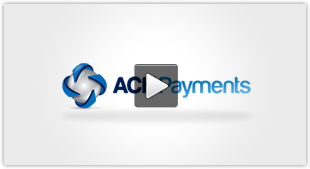Recurring ACH Payments offer business owners a secure, reliable and cost effective method to automate payment collection via the ACH network. ACH payments offer distinct benefits versus credit cards.
Topics
- ACH Advantages Versus Credit Cards
- ACH Payment Collection Options
- ACH History
- Role of ACH Third Party Processors
- ACH Pricing Information
ACH Payment Processing Advantages
1-Up to 90+% savings versus credit cards:
On a $100 recurring payment credit cards may cost $2.50 on average. As a recurring ACH payment that transaction you might pay a flat 30 cents-an 88% reduction. Multiply that by how many customer payments and it does not take long to become significant. Cost reductions are an overlooked tool for improving overall business profitability.
2-Payment decline rates: On average recurring billing credit card declines exceed 10% with some industries seeing 20% declines.
Imagine you are a business owner with 500 customers that you bill $100 per month on a recurring basis. Your business runs and plans based on $50,000 per month coming in the door on a regular basis. It took a long time and a lot of work to get to the point where your business generates that amount of reliable predictable income. You pay salaries, rent, plan development, and manage marketing campaigns ALL around that recurring ACH Payment revenue.
Contact us
For more info on declines click Credit Card Decline Management
Now imagine that 15% of that revenue, or $7,500 per month, goes uncollected — and not because your clients don’t want to pay you.
That is the BIG issue with credit cards. Yes there is a major advantage-you know almost instantly the payment is successful and you will be funded the expected monies but especially with recurring ACH payments the risk of payment issues is very low.
Contrast this with ACH decline rates. You will likely see sub 2% declines. You can see why when you consider how often you change your banking.
Businesses that rely on recurring customer payments know that reliable, predictable cash flow enable a business to better plan for growth, meet financial obligations and if managed properly can create a more valuable business valuation.
There are significant challenges to optimizing recurring payment collection. Most businesses spend a significant amount of time and money acquiring new customers. You are counting on these new customers adding to your recurring revenue stream.
By adding an ACH recurring payment solution OR by actively recruiting your customer base to adopt ACH payments you win on both reducing payment fees and payment declines.
What are your Recurring ACH Payment Collection Options?
CONTACT US for more information

We will examine three.
An ACH Virtual Terminal is a web-based hub that allows businesses to securely accept single and/or recurring payments via ACH [echeck] or credit/debit card. A Virtual Terminal allows the management of Credit Card and recurring ACH transactions, and provides businesses with a secure web browser software application for payment acceptance.
Transactions can be one-times or scheduled, and scheduled transactions can be single future or recurring ACH transactions. The Virtual Terminal can be utilized for transactions by organizations who have preexisting credit card merchant accounts.
2-Payment Enabled Software
You may use a software application that helps you run your business. Your platform provide may have implemented payment collection via an ACH Integration. The integration allows payment origination and reconciliation from with the management software. In looking at using an Integrated ACH solution you want to be aware of how payment rejects or declines are handled.
There are two ways and yours will depend on how tightly the ACH integration was performed.
Let’s look at billing 1000 customers all via ACH on the 1st of each month.
Your platform has two options. In the first as soon as those 1000 transaction are sent to be processed they are also marked as paid. Now it is unlikely all 1000 transaction processed without issue eg NSF (non-sufficient fund). Maybe 15 did not actually fund. Your business will be provided with return information, often via ACH Virtual Terminal and you then go back into your software and back out that payment recording.
Note-Some ACH Processing Providers offer automated NSF resubmission tools that make re-attempting payment collection simple.
The ACH network is a batch environment. This means at the time of payment you have no way to be certain the payment will be successful–the vast majority of times it will.
However this can often lead to accounting reconciliation issues where the platform payment reporting and the customer’s bank statements don’t match.
Having sophisticated ACH Payment Deposit Reconciliation tools allows you to reconcile payments deposits directly in your payment reporting suite. The vast majority of ACH API providers DO NOT offer this level of reporting insight.
The second integration option would involve your software platform reconciling returns for you so that your accounting is always up to date.
Certainly the second option is nicer for you. It is important that you know how ACH returns are handled.
3-Subscription Billing Software
Subscription billing management is big business as companies demand the ability to provide multiple payment options to retain clients and maximize profitability. Prorating, metered billing, trial periods, anniversary billing and other options all contribute to the demand for subscription billing.
Many of these like Chargent may offer a US ACH options as well as Canadian EFT processing.
If your business relies on acquisition tools like free trials as well as upsell and downsell options the subscription billing solution may be the best fit.
A brief history of ACH Processing
The ACH [Automated Clearing House] Network allows for electronic debiting [and crediting] of checking and savings accounts. The network currently operates in the US and Puerto Rico.
Originally created to reduce paper check processing the ACH network began in the 1970’s and was predominately used to collect insurance premiums and mortgage payments in an automated fashion. Payroll direct deposit was and is another strong driver of ACH transaction volume. Today the ACH network processes billions of transactions each year and streamline payment processing for 1000’s of businesses.
The ACH network consists of more than 12,000 financial institutions, 650 industry councils, and a network of regional ACH associations, and is governed by NACHA – The Electronic Payments Association in Herndon, Virginia. The National Automated Clearing House Association was established in 1974 to coordinate efforts to develop a nationwide ACH network, ultimately succeeding in 1978, when all ACH networks nationwide were electronically linked.
In 1980, the ACH Network was changed slightly by the passage of the Monetary Control Act, which allowed for private sector ACH Operators to compete with the Federal Reserve Bank.
Role of the Third Party Processor:
Most banks do not have the tools resources to allow businesses to manage ACH transactions. That is where the Third Party Processor steps in.
The TPP you work with has a relationship with a bank to use their “Fedline”. This is the pipeline that carries transaction data to the Federal Reserve. The processor typically has a good amount of money on deposit with the bank to cover the bank’s risk of fraud and non-payments. The advantage of working with a third party processor is that their front end tools e.g. software, Internet product or integration tools are much more user friendly than a bank.
Pricing Information
What should you know? Pricing is typically a function of volume but you shouldn’t have to pay much more than .35 per transaction and in cases of high volume this can drop considerably. You should not be paying a discount rate in most cases except in higher risk categories. Returns (NSF etc.) should not be costing more than $3.00. Higher risk may change this. Monthly fees no more than $20-25.






